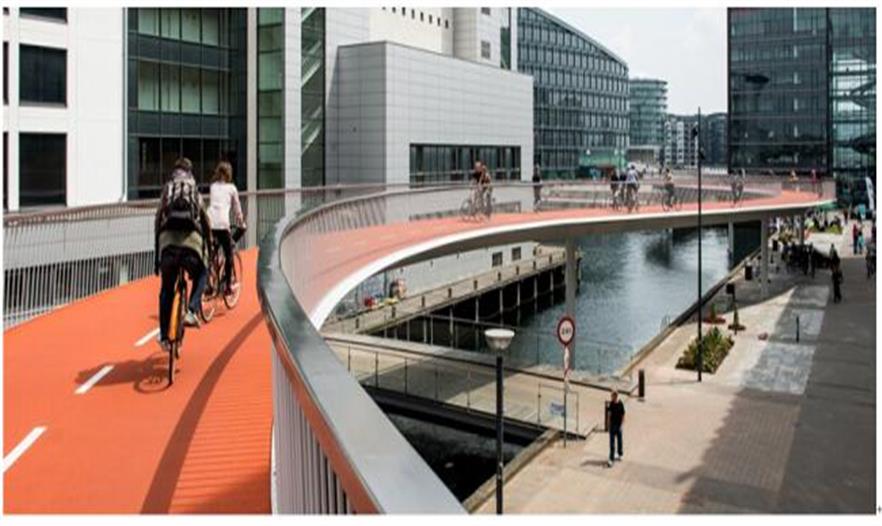姜斌:健康城市、健康景观
姜斌
香港大学建筑学院景观设计学部,助理教授, 电子邮箱:jiangbin@hku.hk。
美国伊利诺伊大学香槟分校博士,博士后,设计工作室讲师。研究方向:健康景观与可持续城市化。
北京大学景观设计学理学硕士,研究方向:生态基础设施规划设计与历史文化景观保护。
其设计师从俞孔坚教授、Peter Walker 及Leslie Wood, 先后就职于北京土人、泛亚国际、Peter Walker and Partners (PWP) 等著名设计机构,先后担任设计师、项目主创、高级项目经理等职务。2005曾荣获美国设计师协会(ASLA)景观规划与分析奖(职业类,团体)。
其研究师从景观认知学派著名学者William C. Sullivan 教授及俞孔坚教授,曾担任美国伊利诺伊大学香槟分校讲师、健康景观与可持续发展研究中心研究负责人及实验室主管。在Landscape and Urban Planning , Environment & Behavior 等顶级学术杂志发表重要论文,其研究被美国、英国、加拿大、日本、新加坡多家媒体报道。
Bin JIANG
Assistant Professor of the University of Hong Kong, Division of Landscape Architecture, Email: jiangbin@hku.hk
Ph.D., post-doctoral researcher, and design studio lecturer of the University of Illinois at Urbana-Champaign. Research interests: healthy landscape and sustainable urbanism
Master of Science in Landscape Architecture, Peking University. Research Interest: ecological Infrastructure and cultural landscape
Design: Jiang was mentored by Kongjian Yu, Peter Walker, and Leslie Wood. Jiang worked for Turenscape, Earthaisa Design Group, PWP as designer, main designer, and senior project manager. In 2005, Jiang was awarded the ASLA professional award of Planning and Analysis (team work)
Research: Jiang was mentored by Prof. William.C. Sullivan, a famous scholar in the field of landscape perception and Prof. Kongjian Yu. Jiang worked asa lecturer in the University of Illinois, senior investigator and manager of the Sustainability and Human Health laboratory. Jiang has published articles in leading journals such as Landscape and Urban Planning, Environment and Behavior. Jiang's research has been reported by professional or public media in U.S., England, Canada, Japan, China, and Singapore
什么是"健康城市、健康景观"
景观中国:能否介绍您所提倡的"健康城市,健康景观"的概念的主要内涵?
姜斌:"健康城市,健康景观"关注城市建成环境及城市景观如何影响城市居民的身心健康、社群健康、及城市的可持续发展。通过对城市功能、空间和景观的规划设计来倡导健康及可持续的生活方式和行为模式,为市民创造清洁、安全、优美、公平的物质空间环境和社会环境。
有两个重要的定义作为这一概念的支撑和我们行动的依据:世界卫生组织在1948年对健康做出了一直沿用至今的定义:"健康不仅是消除疾病或赢弱,也是体格,精神与社会的完全健康。" 1992年联合国发布的《里约环境与发展宣言》提出"人类处在关注持续发展的中心。他们有权同大自然协调一致从事健康的、创造财富的生活。
LAC:Could you introduce on main content of "Healthy City, Healthy Landscape"?
Bin JIANG:"Healthy City, Healthy Landscape" concerns how the built environment and urban landscapes can influence the psychological, physiological, and social health of individuals and lead to more sustainable cities. Through planning and designing physical spaces and landscapes, we can promote healthy and sustainable lifestyles and create clean, safe, pleasant, and equitable environments for people.
Two important statements serve as the foundation for "Healthy City, Healthy Landscape." First, in 1948, the World Health Center defined health as "a state of complete physical, mental and social well-being and not merely the absence of disease or infirmity." Second, in 1992, the United Nations published the Rio Declaration on Environment and Development and claimed "Human beings are at the centre of concerns for sustainable development. They are entitled to a healthy and productive life in harmony with nature." These statements provide justification for our work.
"健康城市、健康景观"在中国
景观中国:为什么"健康城市, 健康景观"的概念对于当前中国有着重要性和紧迫性?
姜斌:经过数十年粗放的城市化和工业化进程,不仅城市环境本身,城市所依赖的自然环境都遭到非常严重的污染、肢解和破坏。在经济挂帅的大背景下,难以量化和归责的环境恶化和健康损失常常被决策者忽略,而我们每一个人,每一个家庭最终都会为之付出沉重的代价。

图1:典型中国城市景观:被人工建筑物和汽车占领的北京国贸立交桥,2013 (图片来源: http://www.todayonline.com)
Figure 1: A Typical Chinese Urban Landscape: A city occupied by artificial constructions and vehicles, Guomao Bridge, Beijing, 2013. Photo source: http://www.todayonline.com.

图2:典型中国城市景观: 清洁工人直接暴露在铜矿泄露的污水中, 福建上杭县, 2010 (图片来源:http://darkroom.baltimoresun.com)
Figure 2:A Typical Chinese Urban Landscape: Laborers work to drain sewage water from a leaked sewage tank at a copper mine in Shanghang, Fujian province, July 13, 2010. Photo Source: http://darkroom.baltimoresun.com

图3:典型性景观:精神压力已经成为中国城市居民的不可承受之重(图片来源:Kevin Frayer/Getty Images)。
Figure 3:A typical Chinese urban landscape:Mental stress is a serious harm for Chinese citizens’ health (Photo Source: Kevin Frayer/Getty Images)
有确凿的数据显示,中国国民的健康状况正在因为环境质量的降低、社会竞争的加剧、不健康生活方式的盛行逐步恶化。这里我给大家举三个方面的数据以管中窥豹:其一,以可导致糖尿病、心血管疾病等致死疾病的肥胖症为例,2010年中国成年人超重的比例为30.6%,肥胖的比例为12.0%。中国未成年人超重和肥胖率分别从1981年至1985年的1.8%和0.4%上升到2006 年至2010年的13.1%和7.5% (Yu et al., 2012)。导致肥胖率剧增的原因虽然是多重的,但其中一个重要的原因是可供休闲和锻炼的城市公共绿地的减少(图1)。其二,快速的工业发展及基础设施建设产生巨大的能源和矿产生产需求,这也带来巨大的健康损失(图2)。过去五十年,中国有超过800个国有矿产公司和23万个私有矿产公司共计产生了约200万公顷被重金属严重污染的荒地;同时采矿和熔炼处理也带来的重金属大气污染问题(Flegal, Gallon, Ganguli, & Conaway, 2013)。其三: 充满压力的城市环境和缺乏舒缓压力和促进身心再生的城市公共空间的缺乏可增加紧张、抑郁、和焦虑的发生率(图3)。2013年研究预测中国罹患抑郁症的人数超过三千万人,其中约90%不能得到及时诊断和治疗,由此导致病情的恶化甚至自杀行为的发生(C hinaResearch &Intelligence, 2013)。
我们所要思考的是, 作为城市环境的规划设计者,能为解决这些危机作一些什么贡献?虽然设计不能解决一切问题,但在西方开展的大量研究和实践工作证明城市环境的改善可以为健康问题做出重要的贡献。中国在这一领域的工作刚刚开始,而我们所面临的健康危机和环境危机又是如此严重。在这一背景下,其重要性和紧迫性是显而易见的。
景观中国:为什么您认为精神健康问题在中国应引起更多的关注? 它与城市环境或城市景观有何联系?
姜斌: 中国城市居民常常忽视精神健康,不愿意承认精神疾患的存在和主动寻求解决方案。目前,在中国城市,特别是一线城市存在着工作竞争激烈、生活成本高、人均社会资源匮乏等现象,这些情况造成城市居民,特别是中青年人群的精神压力极大。精神压力可导致急性心肌梗塞及免疫能力低下,长期的精神压力是高血压、2型糖尿病、和过劳死的主要原因。另外两种主要的精神问题,抑郁和焦躁,在生理机制上被视为人体压力反应机制失调的双重表现。
一方面,在医学研究中,精神压力的危害已经得到明确量化。比如,有研究发现,工作场所的显著精神压力可增加181%的心脏突发疾病死亡率(即2.81倍),100%的女性2型糖尿病患病率,及65%的早期死亡率(Heraclides, Chandola, Witte, & Brunner, 2009; Heraclides, Chandola, Witte, & Brunner, 2012; László, Ahnve, Hallqvist, Ahlbom, & Janszky, 2010)。Nielson等(2008)发现显著的精神压力可增加491%的自杀率,159%的心脏突发疾病死亡率,和79%的呼吸疾病患病率。这些触目惊心的数字告诉我们:精神问题,特别是精神压力其实正在严重侵蚀市民的健康,只是人们并不清楚精神问题与认为需要接受医治的"重要疾病"之间存在如此显著的联系。
另一方面,研究发现接触自然或者城市绿地可起到舒缓压力的效应,并且已经进行明确的量化工作。以本人最近发表的关于绿色街道压力舒缓效应的研究为例:我们使用了压力荷尔蒙(唾液皮质醇)及指尖皮肤收缩率等生理指标来评测人的精神压力水平。对比没有树木的街道景观,被林荫覆盖的绿色街道 (30%的树木覆盖率)可增加约200%(即3倍)的压力舒缓效应(Jiang, Chang, & Sullivan, 2014; Jiang, Li, Larsen,Sullivan, 2014)。Bartoon和Pretty (2010)的论文指出:在绿地里进行5分钟的轻度锻炼(如散步)即可产生显著的改善情绪(增加60%)、提升自尊感(增加70%)的效应。这一类的研究成果都证明自然或城市绿地对提升精神健康起到至关重要的作用。
总而言之,中国城市居民的精神健康问题其实相当严重,其原因当然是多样和复杂的,在病理发展机制上,城市景观可为人们提供舒缓压力,恢复精力的场所,避免将日常的急性精神压力累积为长期的、慢性的压力,最后发展成具有显著健康危害或社会危害的精神疾病。
LAC:Why do you think it is important and pressing to promote the idea of "Healthy City, Healthy Landscape" in China?
Bin JIANG:After decades of wild urbanization and industrialization in China, the urban environment and the nature that supports this environment have been seriously polluted, dismantled, and damaged. In a country where economic accomplishment is always the priority, policy makers seldom give attention to environmental degradation because this degradation can be difficult to quantify. It is also difficult to decide who is at fault and who should take responsibility for this degradation. Unfortunately, Chinese citizens are already paying a high price for this neglect.
Empirical evidence indicates that Chinese citizens' health is rapidly declining, caused in part by environmental degradation, social competition, and unhealthy lifestyles. I will address three ways in which human health is declining. First, there are fewer outdoor green places for recreation and physical activity (Figure 1). People are spending less time outdoors, leading them to become more overweight and obese. In 2010, 30% of adults in China were overweight, and 12% were obese. For young people less than 18 years old, the overweight and obesity rates have increased from 1.8% and 0.4% in 1980s (1981-1985) to 13.1% and 7.5% in 2010s (2006-2010). This is especially concerning because obesity can lead to fatal diseases such as diabetes and cardiovascular diseases. Second, the pollution from rapid industrialization and construction of infrastructure also contributes to health decline (Figure 2). Within the last 50 years, more than 800 nationally owned and 230,000 private mining companies polluted 2,000,000 ha of land; mining and treatment processes also have polluted the air. This pollution is causing increased rates of respiratory illnesses such as asthma and lung cancer. Third, a stressful urban environment and lack of green space can lead to increased rates of stress, depression, and anxiety (Figure 3). A recent study published in 2013 estimated that more than 30 million Chinese citizens suffer from depression. Approximately 90% of these citizens are not diagnosed and treated, which may lead to more serious symptoms and even suicide (China Research &Intelligence, 2013).
In short, China faces serious environmental problems that are leading to human health decline. As designers of urban environments, we have a responsibility to help solve these problems. Research and design in the West demonstrate that improving urban environments can significantly promote human health. In China, research and design in environment and human health are still in their infancy. We need to make this important work more of a priority.
LAC:Why should we pay more attention to mental health problems? How does the urban environment and landscape impact mental health?
Bin JIANG: Chinese citizens oftenneglect mental health problems; they are reluctant to even admit the existence of these problems, let alone solve them. One such problem is chronic mental stress. High competition at work, high living costs, and low levels of social resources are leading to significant, chronic stress among Chinese citizens. Mental stress can cause stress cardiomyopathy and low effectiveness of immunization system. Chronic stress is the main cause of high pressure, type 2 Diabetes, obesity, and Karoshi. As other two main mental problems, anxiety and stress can both be regarded as an impaired stress response.
Clinical research has clearly quantified the harm of untreated mental stress to human health. For example, recent studies reported untreated mental stress at work can increase the risk of death from heart attack by 181%, the risk of type 2 diabetes in women by 100%, and the risk of early death from all causes by 65% (Heraclides et al., 2009; Heraclides et al., 2012; László et al., 2010). Nielson and colleagues(2008)reported significant stress levels can increase the risk of suicide by 491%, the risk of death from heart attack by 159%, and the risk of respiratory disease by 79%.. These astonishing numbers alarm us: mental health problems, in particular mental stress, are damaging Chinese citizens' health.
Fortunately, researchers have found that contact with nature or urban green space can reduce stress and other mental health problems in significant, measurable ways. My own research demonstrates this clearly. Participants who viewed a five-minute video of street scenes with a moderate level of tree cover (30%) had 3 times greater stress reduction than those who viewed a video of a treeless street scene( Jiang et al., 2014; Jiang, Li, Larsen, Sullivan, 2014). Bartoon and Petty (2010)found that spending approximately 5 minutes doing light exercise (such as walking) in a green environment can significantly increase positive emotions (by 60%) and self-esteem (by 70%). This research suggests that nature or urban green spaces can promote citizens' mental health.
Chinese citizens' mental health is seriously challenged by complex environmental and social factors. Green urban landscape can provide spaces for citizens to recover from stress and attention fatigue. Exposure to such places can help prevent daily, acute stress from becoming chronic stress, which can seriously harm human health and social cohesion.
改变城市景观,提升公众健康
景观中国:从哪些具体方面来改变城市景观以提升公众健康?
姜斌:概括来说,可以从几个方面来开展。首先,我们要解决污染问题,通过规划设计调整城市土地利用方式和产业组合,尽量减少污染对市民健康的影响,这一概念,我想借鉴北京大学建筑与景观设计学院院长俞孔坚教授提出的"海绵城市景观"这一概念,城市景观如何通过缓冲、过滤,阻隔,和处理污染物质,起到保护居民健康的作用,是一个值得深入研究的课题。
其次,我们要通过城市景观的营造刺激健康生活方式的养成,倡导积极的城市生活(Active living),鼓励人们走出房间,亲近自然,亲近邻里,投身户外健身和休闲活动。此外,我们要通过城市景观的营造提供人们身心再生的场所。都市居民为生存与发展承受着巨大的心理压力,而绿色景观能有效地舒缓压力和恢复注意力。最后,城市景观对社会健康亦起到积极的作用,好的景观设计可抑制犯罪行为的发生,鼓励市民之间的友好交往,提升市民之间的信任感,保证所有的市民都有平等地使用城市绿地、享受公共空间和公共服务的机会。
景观中国:在中国的文化、社会、经济背景下,是什么原因驱使我们的城市环境和城市生活背离健康发展的方向的?设计师对此能做什么?
姜斌: 有两个问题是关键的。其一,在这个消费时代,在灰色丛林般的城市里,人们逐渐失去了欣赏自然的机会和能力。人们大部分对自然的认知是透过电子媒介来实现的,我们所认识的自然只是二手的,虚拟的自然,是他人制造的图像消费品。因此,人们对于自然的认知能力逐渐变得迟钝和残缺。如果生于八零年代前的人们还存有对自然中国和乡土中国的依稀记忆,那么当代的青少年儿童则大多是在远离自然的城市人工环境和虚拟的电子世界中成长起来的,自然对于他们来说是完全陌生和无关的。因此,作为设计师,一个迫切的任务就是将真实的、乡土的自然美带到城市生活,因为只有真实的自然才能唤醒人们对环境真实的理解、尊重和热爱。而这种理解和爱的能力是创造健康城市的根本途径。

图9:隐蔽的欺骗:商家通过制造产品与当代价值观之间的联系以控制“理想生活模式”的图景和刺激过度消费。(图片来源:http://www.vintageadbrowser.com/cars-ads)
Figure 9: A subtle deception: Businesses manipulate the image of ‘deal lifestyles’ and stimulate over-consumption by making a connection between contemporary values and their products. Photo source: http://www.vintageadbrowser.com/cars-ads.

图 10:设计师需要让市民相信健康的生活方式可以很酷: 丹麦哥本哈根的蛇形自行车桥。 (图片来源:Copenhagen's X Galary, http://www.dac.dk/)
Figure 10: Designers should convince citizens that healthy life can be cool: Copenhagen's new cycle bridge The Bicycle Snake (Photo Source: Copenhagen's X Galary, http://www.dac.dk/)
其二,健康城市的发展受到不健康的、高能耗的、过度消费的、源于西方的城市生活理念和方式的冲击。根本上而言,我认为存在两个重要挑战:第一个挑战,我们的城市常常缺乏文化的自信,我们的发展一直走在效仿西方大城市的老路上,而且在不断重复它们半个世纪前就曾犯过的错误。在这一点上,我特别感激俞孔坚教授过去二十年的工作,通过景观设计唤醒中国人的文化自信,创造和保护属于中国人的独特人文景观和生活场所。第二个挑战,如何通过设计改变不可持续、不健康的生活方式呢?我们首先应当尊重人们追求富足、平等、自由、自尊、安全和隐私的权利。为了刺激消费,商家常常将理想生活价值观与他们的商品划上等号,如私家汽车、郊野别墅、私人游艇、饕餮盛宴等(图9)。这实际上是一种非常隐蔽的欺骗。这种过度消费的"理想生活方式"将不可避免地导致环境的污染、不可再生资源的枯竭、自然环境的破碎、和身心健康的受损,即就是所谓的"公地悲剧"。不幸的是,简单地否定或劝阻人们过度消费将是徒劳无功的。作为设计师,需要让人们相信其实他们的理想愿景可通过健康和可持续的方式来实现的,而这样的生活方式也是很吸引人的(图10)。作为设计师来说,应该倡导健康的、不自私的、文化自信的城市生活。
LAC:Could you give us some ways we can change urban landscapes to promote public health?
Bin JIANG: First, we need to solve environmental pollution problems. By adjusting land use regulations and reconstructing industries, we can reduce the harm caused by pollution. We can also create what Kongjian Yu calls "sponge urban landscapes." It is an important question for us to examine how urban landscapes canbuffer, filter, stop, and treat pollutants to protect our citizens' health.
Second, we need create urban landscapes that stimulate healthy lifestyles, promote active living, and encourage people to leave their rooms. Such urban landscapes will include contact with nature, spaces for social interaction, and opportunities for exercise, active transportation, and recreational activities. It is important to assure all citizens can have equal access to public green spaces, facilities and services.
LAC:Considering the cultural, social, and economic contexts in China, why are urban environments and urban life deviating from healthy development, and what can we do to address these challenges?
Bin JIANG: First, Chinese citizens are gradually losing the opportunity and capability of appreciating nature. Mostly, our citizens perceive nature through electronic media. They only see a processed nature, a fake, second-hand, commercial product. Thus, people's perception of nature becomes obscure and incomplete. People born in or before the 1980s still may vaguely remember a natural or vernacular China, but the younger generations are growing up in urban environments that are far away from nature. Nature is provided by a virtual electronic world and is something distant and strange. Under these circumstances, designers have a responsibility to bring the pristine and authentic beauty of nature back to urban life. Only in this way can citizens truly understand, respect, and love the environment. People will be more likely to reap positive health benefits from natural environments they understand and love.
Second, healthy urban development is challenged by unhealthy, high energy-consuming, and over-consuming western urban attitudes and lifestyles. We are deliberately following the development of big cities in the Western world and repeating mistakes they made half a century ago.Instead, we should gain confidence in our own culture and landscapes. Designers in China can help reconstruct the cultural confidence of our cities and citizens. A lovely example comes from Prof. Kongjian Yu's work of the last twenty years. He successfully rebuilt Chinese citizens' cultural confidence through creatingand preserving unique cultural landscapes and living environments.
Unhealthy, high-consuming attitudes are difficult to change. We should respect every citizen's right to pursue prosperity, equality, freedom, self-esteem, safety, and privacy. In order to stimulate over-consumption, businesses manipulate the image of 'deal lifestyles' and by making a connection between contemporary values and their products (a private car, rural house, luxurious yacht, or a sumptuous feast) (Figure 9). In fact, it is a deception, a very subtle deception! Overconsumption in the pursuit of this ideal lifestyle inevitably leads to environmental pollution, depletion of unrenewable resources, fragmentation of the natural environment, and harmed human health. Simply denying or discouraging people from overconsumption may not work. Instead, our goal as designers is to make healthy and sustainable ideas and solutions appealing (Figure 10). We need to convince our citizens that the ideal life can be reached in healthy and sustainable ways. For designers, it is fundamentally important to promote healthy, unselfish, and culturally confident urban life.
"健康城市, 健康景观"专家合作网络
景观中国:能否介绍一下您在美国及亚洲建立的"健康城市, 健康景观"专家合作网络, 这个网络的主要目标和工作内容?
姜斌:近五年来,我与William. C. Sullivan教授及张俊彦教授一起致力建立一个国际性的研究和设计实践网络。Sullivan教授是美国环境学科主任委员会前任主席,伊利诺伊大学健康与可持续发展研究实验室主任。张俊彦教授是台湾大学"健康景观,健康人民"实验室主任和本领域的世界著名学者。我们已经与哈佛大学、加州大学洛杉矶分校、北京大学、台湾大学、香港大学、美国景观设计师协会 (ASLA)、美国环境设计学会(ERDA)、美国国家森林署(USDA Forest Service)等世界著名高校或组织展开学术交流或教育交流活动(图4)。我们的目标是在全球范围内,鼓励和帮助各国的学者和规划设计师,基于不同的文化、社会、和地理背景,针对建成环境如何影响健康这一重要课题进行研究和设计实践。同时,如何与景观生态学、可持续城市规划与设计、环境污染治理、大众健康、大数据管理与分析等专业进行有效的合作也是我们关注的课题。

图 4:我们透过伊利诺伊大学香槟分校与台湾大学等多所亚洲高校进行学术互访和教育合作。
Figure 4:Scholars at the University of Illinois are cooperating with Taiwan University and other distinguished universities in Asia to address these issues.

图5:美国景观设计师协会(ASLA)年城市景观与大众健康专题会议。主讲专家:Richard J. Jackson, Richard Sutton, Terry Huang, 姜斌。 奥马哈市,内布拉斯加州。
Figure 5: American Society of Landscape Architecture Conference on Healthy Landscape. Main speakers: Richard J. Jackson, Richard Sutton, Terry Huang, Bin Jiang. 2014. Omaha, NE.

图6:让都市重归自然 (姜斌作品:武汉中山舰纪念公园,图片来源:泛亚国际)
Figure 6: Let city belong to nature again (Bin Jiang’s work: Wuhan Zhongshan Memorial Park, photo source: Earthasia Design Group)

图 7:寻找每一个机会在坚硬而光滑的都市中植入自然(姜斌作品:上海虹桥国际机场景观)
Figure 7: Find every opportunity to plant poetic nature into the tough, sleek urban environment. (Bin Jiang’s work: Hongqiao International Airport Landscape, Shanghai, China)

图 8:社区设计应倡导积极的生活方式,让儿童与自然一起生长 (姜斌作品: 花桥国际商务金融中心及社区,图片来源:泛亚国际)
Figure 8: The neighborhood should stimulate active living. Let children grow up with nature (Bin Jiang’s work:Huaqiao International Business Park and Neighborhood)
我们正在努力的事情包括:致力开展定量研究工作,推动以科学证据为驱动力的设计实践,为政府决策提供明确的科学依据;发表介绍这一领域先进理念、研究方法、和重要研究问题的著作,进行学术宣讲(图5),希望能够影响到更多的学者,特别是年轻的学者,投身到透过改善城市环境来改善市民健康和社会健康这一重要的行动中;独立或与著名设计事务所合作在全球多个城市开展设计实践,通过实际项目示范、检验、和发展我们的理念和方法(图6,7,8)。
LAC:Could you introduce the network of experts in the U.S. and Asia who are developing the "Healthy City, Healthy Landscape"initiative? What is the main goal and task of that network?
Bin JIANG: In the lastfive years, I have worked closely with Prof. William C. Sullivan and Prof. Chun-Yen Chang to construct an international network of research and design practice devoted to creating built environments that improve human health. Prof. Sullivan is thepresident of the Council of Environmental deans and directorsand also thedirector of the Sustainability and Human Health laboratory at the University of Illinois in the U.S. Prof. Chang is a leading scholar in the field and the director of "healthy landscape, healthy people" lab in the National Taiwan University. We have strong collaborative ties with several distinguished universities or institutions, including Harvard University, University of California in Los Angles, Tokyo University, Taiwan University, University of Hong Kong, the American Society of Landscape Architecture (ASLA), the Environmental Research Design Association in U.S. (EDRA), and the U.S. Forest Service (Figure 4). Our goal is to support research about the built environment's influence on human health, and then to encourage scholars, designers and planners to use our research to create healthier built environments. Because these issues involve many disciplines, we collaborate with scholars in a variety of fields: landscape ecology, sustainable urban planning and design, environmental pollution management, public health, and big data management.
We conduct quantitative research to promote evidence-based design and to provide concrete evidence to support decision making. We publish books and journal articles to introduce pioneering ideas, research methods, and important research questions. We also give lectures and seminars to encourage more scholars, especially young scholars, to work with us to address these research questions (Figure 5). Informed by our research, we practice design independently and with other distinguished design firms in several cities all over the world.
参考文献 (References)
Barton, J., & Pretty, J. (2010). What is the best dose of nature and green exercise for improving mental health? A multi-study analysis. Environmental Science & Technology, 44(10), 3947-3955. doi: 10.1021/es903183r
Flegal, A. R., Gallon, C., Ganguli, P. M., & Conaway, C. H. (2013). All the lead in china. Critical Reviews in Environmental Science and Technology, 43(17), 1869-1944.
Heraclides, A., Chandola, T., Witte, D. R., & Brunner, E. J. (2009). Psychosocial stress at work doubles the risk of type 2 diabetes in middle-aged women: Evidence from the whitehall ii study. Diabetes Care, 32(12), 2230-2235.
Heraclides, A. M., Chandola, T., Witte, D. R., & Brunner, E. J. (2012). Work stress, obesity and the risk of type 2 diabetes: Gender-specific bidirectional effect in the whitehall ii study. Obesity, 20(2), 428-433.
China Research &Intelligence (2013). Research report on china's antidepressant market, 2013-2017. Retrieved from http://www.researchandmarkets.com/research/b7j88d/research_report, 2014/12/28.
Jiang, B., Chang, C. Y., & Sullivan, W. C. (2014). A dose of nature: Tree cover, stress reduction, and gender differences. Landscape and Urban Planning, 132, 26-36.
Jiang, B., Li, D., Larsen, L.,Sullivan, W. C. . (2014). A dose-response curve describing the relationship between urban tree cover density and self-reported stress recovery. Environment and Behavior. doi: 10.1177/0013916514552321
László, K. D., Ahnve, S., Hallqvist, J., Ahlbom, A., & Janszky, I. (2010). Job strain predicts recurrent events after a first acute myocardial infarction: The stockholm heart epidemiology program. Journal of Internal Medicine, 267(6), 599-611.
Nielsen, N. R., Kristensen, T. S., Schnohr, P., & Grønbæk, M. (2008). Perceived stress and cause-specific mortality among men and women: Results from a prospective cohort study. American Journal of Epidemiology, 168(5), 481-491.
Yu, Z. B., Han, S. P., Chu, J. H., Xu, Z. Y., Zhu, C., & Guo, X. R. (2012). Trends in overweight and obesity among children and adolescents in china from 1981 to 2010: A meta-analysis. Plos One, 7(12). doi: 10.1371/journal.pone.0051949
致谢:感谢北京大学俞孔坚教授、李迪华教授、佘依爽主编、泛亚国际田明总经理、及同僚黄宇凌、周丹瑶、纪文琦、张恬对本次访谈的支持。感谢Linda Larsen和韩韫娇的修订工作。
Acknowledgements: Thanks for support from Prof. Kongjian Yu, Prof. Dihua Li, and Editor Yishuan She from the Peking University, Mr. Ming Tian from the Earthasia Design Group, and my colleagues including Yuling Huang, Danyao Zhou, WenqiJi, and Tian Zhang. Thanks for review from Linda Larsen and Yunjiao Han.









发表评论
热门评论